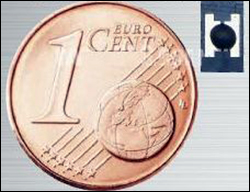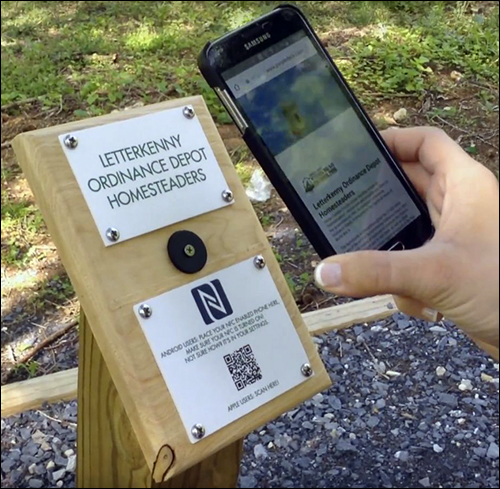The following are news announcements made during the past week by the following organizations:
Securitag Assembly Group, STMicroelectronics;
GuardRFID;
Purple Deck Media; and
Smart Technology Group, Cempel Consulting.
SAG, ST Deliver Tiny NFC Tag for IoT Applications
Semiconductor company STMicroelectronics and Securitag Assembly Group (SAG), a supplier of RFID transponders, have announced a tiny Near Field Communication (NFC) tag that uses STMicroelectronics’ ST25 NFC tag IC designed for Internet of Things (IoT) data-transmission applications, especially in consumer electronics, wearable devices and smart health-care products. The NFC Ferrite Tag (0503), made with sintered ferrite antenna, measures just 4.9 millimeters by 3.0 millimeters by 2.5 millimeters (0.2 inch by 0.12 inch by 0.1 inch)—which, the companies say, makes it suitable for wearable products, for which compactness is critical.
The NFC Ferrite Tag can be surface-mounted during production through the metal pad that can be directly soldered to the PCB surface. The tag can function when placed on metal products, according to the two companies, due to its anti-metallic interference characteristics. ST’s ST25TA02K NFC Forum Type 4 tag IC supports the NFC Data Exchange Format (NDEF), so the NDEF data can be directly executed via an Android NFC smartphone without any dedicated application software. In addition to NDEF support, the ST25TA02K features a 20-bit counter and a 128-bit password to protect read-write access to the 2 kilobits of EEPROM memory.
The two companies report that they will collaborate to meet the growing NFC demand that is expected to drive new IoT and wireless applications for smart home, health-care, city and factory environments. With ST’s global reach and semiconductor leadership, combined with SAG’s professional manufacturing of RFID tags, the partners say they aim to accelerate innovation and new product development in order to strengthen the competitiveness of their customers’ final products.
Samples of the NFC Ferrite Tag are available at SAG’s website. Samples of ST’s ST25TA02K NFC Tag IC are available at STMicroelectronics’ site.
GuardRFID Field-Trials Solar-Powered RTLS Solution for Hazardous Areas
GuardRFID, a provider of active RFID and real-time location system (RTLS) technologies for industrial environments, has announced that it has successfully completed field trials of its solar-powered and fully wireless RTLS solution. The system is suitable for deployment at remote locations, the company reports, or where power and/or connectivity may not be easily available.
The trial was conducted at a test yard of a major oil and gas exploration company in the West Texas Permian Basin in early December 2015. Since then, according to the company, the solar-powered system has exceeded performance goals that had been set at the beginning of the trial.
GuardRFID’s active RFID technology is compliant with the IEEE 802.15.4 standard, the firm reports, and operates at 433 MHz—a frequency band suitable for global consumption and not constrained by local regulatory requirements. The entire trial used Wi-Fi communications for local connectivity within the yard, and a cellular uplink from the yard to one of GuardRFID’s enterprise RTLS servers in Vancouver, Canada.
GuardRFID tags, intended for deployment in hazardous areas, are certified for use in the most explosive environments, designated as Zone 0 (IECEx/ATEX classification) or Class1/Div1 (UL/CSA classification). Several such tags, certified as being intrinsically safe devices, are available for placement on personnel, as well as on small or large equipment, GuardRFID reports. These tags operate within a system comprising GuardRFID’s infrastructure devices (Industrial Tag Reader – EX, and Industrial Tag Exciter – EX) that also carry IECEx and UL/CSA certifications for use in hazardous environments.
“We have been deploying our RFID/RTLS technology in industrial environments for several years now, but this is the first time we have eliminated all the wiring from a system installation,” said Dalibor Pokrajac, GuardRFID’s CTO, in a prepared statement. “This six months trial, conducted in an environment which is a true representation of a remote industrial site that lacks electrical power and network connectivity, has truly demonstrated our system’s robustness and versatility. This, combined with the highest hazardous area certifications our equipment carries, and the system’s compatibility with worldwide regulatory requirements, further enhances GuardRFID’s position as a dominant supplier of RTLS technology for large scale industrial enterprises that have a global footprint.”
Purple Deck Media RFID-enables Veterans’ Trail of Service
Purple Deck Media, a cloud-based software and Near Field Communication (NFC) RFID technology company specializing in mobile applications, has announced that it has NFC-enabled a memorial trail in Pennsylvania’s Franklin County Veterans and 9/11 Memorial Park. The company installed 20 digital-access kiosks along the 600-foot-long, 5-foot-wide Trail of Service. Using their NFC-enabled smartphones, visitors can tap the NFC chip on any of the kiosks to learn more information about the Historic Letterkenny Chapel, the Veterans and 9/11 Memorial Park, and other park-related topics of interest.
The trail was constructed by CASHS Navy Junior R.O.T.C. Cadets, the Boy Scouts of America and other community organizations and volunteers, according to Purple Deck Media. The historical park honors all U.S. military veterans, prisoners of war, and service men and women missing in action, as well as the casualties of Sept. 11, 2001, and the first-responders and citizens who saved lives. The memorial was dedicated by the First Counselor to the Apostolic Nuncio, the Vatican’s Ambassador to the United States, just as was done by the Apostolic Nuncio for this military chapel in 1945. That same year, Italian prisoners of war, housed at Letterkenny Army Depot, built the chapel, using stone from many of the original farmhouses on the depot site. The chapel features a 65-foot Florentine belfry, a San Francisco entrance and a Roman interior.
Purple Deck Media, which owns and operates the Proximity Shop website, installed and manages the NFC tags along the trail, using its Heavy Duty On-Metal NFC Coin Tag. The durable, waterproof tag, made with NXP Semiconductors‘ NTAG213 chip, is circular, measuring 30 millimeters (1.2 inches) in diameter and 3 millimeters (0.12 inch) in thickness. It has a cutout in its center so that it can be affixed via a screw, according to Purple Deck Media, and also comes with a 3M adhesive backing for mounting purposes.
TapLive, Purple Deck Media’s cloud-management platform for NFC and Internet of Things applications, provides a means of streamlining content delivery and aggregate information. The park is using TapLive to manage the digital kiosks and to modify the content delivered to NFC devices. The company also offers MobileDeck, which is designed to accelerate mobile application development and was used to develop the Veteran Trail PA app, which can be downloaded from the Google Play website.
Smart Technology Group Offers RFID Simulation
Smart Technology Group has announced that it is working with Cempel Consulting to offer an RFID simulation service designed to provide a visual representation of RFID technology benefits.
The simulation offering employs computer animation and precise calculation to help illustrate whether RFID is worth considering, according to Smart Technology Group. “I have been dealing with RFID technology for eight years and for many times I have seen how retail representatives are skeptical about RFID,” said Karolina Kozlowska, the company’s CEO, in a prepared statement. “This is why we put so many efforts into educational activities that raise awareness about RFID. We write reports and publications, publish movies and presentations. But now we have completely new and quite powerful tool.”
The simulation tool’s key function is to visualize all benefits from implementing RFID for retail. Based on discrete event manufacturing simulation software supplied by FlexSim Software Products, the tool can easily compare how much time and how many warehouse employees, for example, are required to perform a full inventory or complete shipping processes. The tool uses actual data—number of employees, warehouse dimensions, carrying capacity, number of pallets—to make calculations. As a result, the company says, it is possible to generate objective comparisons and clearly determine whether an RFID implementation bring benefits. If RFID will deliver benefits, the solution can also determine how many minutes can be saved in every process, or how many employees could be delegated to other duties.
Smart Technology Group’s experts will prepare the scheme of an optimal RFID system, the company reports. “Our newest offer has indisputable potential to be the final and most convincing case for introducing RFID,” Kozlowska said in the statement. “We can generate real numbers that will support the decision if implementing this wireless technology. And you cannot argue with numbers.”



